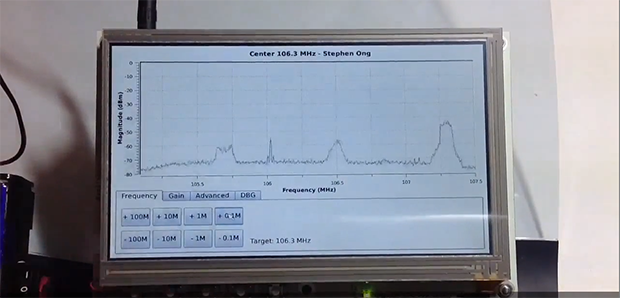With the combination of small, powerful, and pocketable computers and cheap, off-the-shelf software defined radio receivers, it was only a matter of time before someone built a homebrew spectrum analyzer with these ingredients. This great build is the project of [Stephen Ong] and he’s even released all the softwares for you to build this on your own.
The two main components of this build are a BeagleBone Black and its 7″ Touchscreen cape. The BeagleBone is running Angstrom Linux, a blazingly fast Linux distro for small embedded devices. The radio hardware consists of only a USB TV tuner supported by RTL-SDR. In his demo video, [Stephen] shows off his project and by all accounts it is remarkable, with a UI better than most desktop-oriented SDR software suites.
You can grab the BeagleBone image [Stephen] is using over on his blog, but for more enterprising reader, he’s also put up the source of his ViewRF software up on GitHub.
















Huh, has HaD featured the BeagleBones much? I believe this is the first time I’ve actually seen it feature so prominently.
We’ve done a few BB projects, but it’s a function of what gets sent into the tip line.
Everybody has a Raspi, so obviously we’re going to get more Pi builds in our inbox.
It is far simpler and better if you just pair up your RTL-SDR with SDRsharp software on any PC.
Simpler is true, but better is very objective. Try to keep an open mind and not jump to the “I know best” perspective immediately.
I think you misinterpreted my comment. I used the word “simpler” for a reason. And like you said, “better” is subjective. To me, adding a $10 device to a pre-existing computer system instead of buying a spectrum analyzer for several thousand dollars is definitely “better”.
I don’t have experience with SDRsharp but for me the value of this project lies in the data interface. The guy wrote a tool that processes the raw samples and shows them on a nice GUI. Anybody like me who wondered how to grab the stream and do something with it but hasn’t got the time to wade through yet another pile of docs and sources can get started in minutes with this stuff.
Nice! He doesn’t show what antennae he’s using, though. Or, does it matter for this application?
Anyway, well done.
I’m not sue why he felt the need to put that annoying music over his talk (the video)
Anyway I was expecting some new angle or trick maybe but it really is just your classical RTL-SDR but done on a portable setup. Now I’m wondering though if you could use a commercial android style tablet and run another (from android) linux on it to do this. Might be handy if you can get a budget tablet or upgraded and want to do something with the old setup.
all you need is a rooted tablet (for the usb rtl-sdr driver), porting should be easy, Even 40 dollar (DX.com has 1GHz A7 JXD S18 v3 with rockchip RK2926) has neon math coprocessor and should run this very code well.
Is that really a spectrum analyzer or a SDR receiver using a Beagleboard?
Spectrum Analyzers plot RF Signal Amplitude (Y-Axis) vs. Frequency (X-Axis). I don’t see why an SDR receiver using a Beagleboard running software to plot these attributes would “not” be a spectrum analyzer.
Is this an 8563B? Not even close, but there are literally tons of uses for simple RF analysis. Not everyone needs 1hz resolution bandwidth and coverage from 9khz to 26.6ghz. Maybe I just want to make sure I’m picking the least congested channel for my WiFi AP or wireless microphones.
Add in an HF upconverter and this would be right at home next to my IC-706!
-KC9SWV
“Maybe I just want to make sure I’m picking the least congested channel for my WiFi AP or wireless microphones.”
Now I really have to build one. (c:
Sorry, none of the tuners for RTL-SDR go up to the 2412 to 2484 MHz range http://sdr.osmocom.org/trac/wiki/rtl-sdr#Specifications
A Spectrum Analyzer is just an amplitude vs. frequency two dimensional plot. That is the correct answer. What is an issue is the resolution and quality of signal processing, but that directly depends on the application you want the device to work on…. and this option is a good one.
They’re now working direct sampling mode for HF on RTL-SDR, so with a little fine soldering work, you can get right down to DC if you want. You need to add a lead to the quadrature input, as I understand it, so that you’re injecting the RF straight into the ADC.